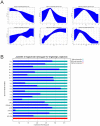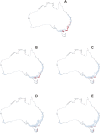The effect of global warming on the Australian endemic orchid Cryptostylis leptochila and its pollinator
- PMID: 36716308
- PMCID: PMC9886262
- DOI: 10.1371/journal.pone.0280922
The effect of global warming on the Australian endemic orchid Cryptostylis leptochila and its pollinator
Abstract
Ecological stability together with the suitability of abiotic conditions are crucial for long-term survival of any organism and the maintenance of biodiversity and self-sustainable ecosystems relies on species interactions. By influencing resource availability plants affect the composition of plant communities and ultimately ecosystem functioning. Plant-animal interactions are very complex and include a variety of exploitative and mutualistic relationships. One of the most important mutualistic interactions is that between plants and their pollinators. Coevolution generates clustered links between plants and their pollen vectors, but the pollination and reproductive success of plants is reduced by increase in the specialization of plant-animal interactions. One of the most specialized types of pollination is sexual deception, which occurs almost exclusively in Orchidaceae. In this form of mimicry, male insects are attracted to orchid flowers by chemical compounds that resemble insect female sex pheromones and pollinate the flowers during attempted copulations. These interactions are often species-specific with each species of orchid attracting only males of one or very few closely related species of insects. For sexually deceptive orchids the presence of a particular pollen vector is crucial for reproductive success and any reduction in pollinator availability constitutes a threat to the orchid. Because global warming is rapidly becoming the greatest threat to all organisms by re-shaping the geographical ranges of plants, animals and fungi, this paper focuses on predicting the effect of global warming on Cryptostylis leptochila, a terrestrial endemic in eastern Australia that is pollinated exclusively via pseudo copulation with Lissopimpla excelsa. As a species with a single pollinator this orchid is a perfect model for studies on the effect of global warming on plants and their pollen vectors. According to our predictions, global warming will cause a significant loss of suitable niches for C. leptochila. The potential range of this orchid will be 36%-75% smaller than currently and as a result the Eastern Highlands will become unsuitable for C. leptochila. On the other hand, some new niches will become available for this species in Tasmania. Simultaneously, climate change will result in a substantial expansion of niches suitable for the pollinator (44-82%). Currently ca. 71% of the geographical range of the orchid is also suitable for L. excelsa, therefore, almost 30% of the areas occupied by C. leptochila already lack the pollen vector. The predicted availability of the pollen vector increased under three of the climate change scenarios analysed. The predicted habitat loss is a serious threat to this orchid even with the potential colonization of Tasmania by this plant. In the reduced range of C. leptochila the pollen vector will also be present assuring fruit set in populations of this orchid. The genetic pool of the populations in New South Wales and Queensland will probably be lost.
Copyright: © 2023 Kolanowska, Michalska. This is an open access article distributed under the terms of the Creative Commons Attribution License, which permits unrestricted use, distribution, and reproduction in any medium, provided the original author and source are credited.
Conflict of interest statement
The authors have declared that no competing interests exist.
Figures







References
-
- Martorell C, Freckleton RP. Testing the roles of competition, facilitation and stochasticity on community structure in a species-rich assemblage. Journal of Ecology. 2014;102(1):74–85.
-
- Grime JP. Benefits of plant diversity to ecosystems: immediate, filter and founder effects. Journal of Ecology. 1998;86(6):902–10.
Publication types
MeSH terms
LinkOut - more resources
Full Text Sources
Research Materials

